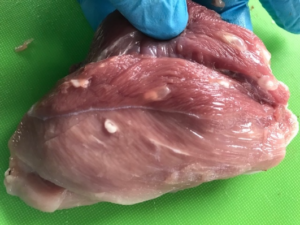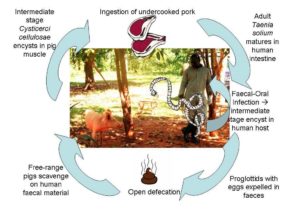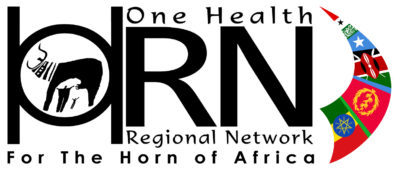
 Dr Annie Cook is a veterinary epidemiologist at the International Livestock Research Institute (ILRI) in Nairobi and holds an honorary position at the Institute of Infection and Global Health, University of Liverpool. Annie and has been working on One Health research projects in East Africa since 2010, focusing on the control of porcine cysticercosis as part of the HORN project.
Dr Annie Cook is a veterinary epidemiologist at the International Livestock Research Institute (ILRI) in Nairobi and holds an honorary position at the Institute of Infection and Global Health, University of Liverpool. Annie and has been working on One Health research projects in East Africa since 2010, focusing on the control of porcine cysticercosis as part of the HORN project.

Porcine cysticercosis is a parasitic condition of pigs caused by the larval stage of the tapeworm Taenia solium (Figure 1). In pigs, the parasite does not cause significant disease. However, in people the disease has two forms; (i) the adult tapeworm can cause abdominal pain and gastrointestinal dysfunction (ii) the larval form of the parasite can cause cysts in the nervous tissues particularly the brain. The second condition, called neurocysticercosis, is a very serious, life-threatening condition.
Neurocysticercosis is the leading cause of acquired epilepsy worldwide. Unfortunately, the vast majority of affected people live in low and middle income countries and do not have access to appropriate health care services and treatment. There is a large treatment gap in the management of epilepsy in these regions and combined with the social stigma associated with the condition, people living with epilepsy often do not have the same opportunities as other members of the community.
Transmission of the parasite occurs in several ways (Figure 2). People become infected with an adult tapeworm by eating undercooked pork containing cysts. If the faeces of an infected tapeworm carrier find their way into drinking water or pasture, pigs and people can become infected with the larval stage by ingesting the eggs.

(Thomas, 2014)
Control Options for cysticercosis may be focused on preventing or treating the infection in people or can be animal focused. Human interventions include improved sanitation, targeted deworming of tapeworm carriers and education programmes regarding the life cycle of the parasite. Animal interventions include improved meat inspection, deworming and vaccination of pigs. These interventions have often been done in isolation. In recent years, a One Health approach incorporating both human and animal approaches has been advocated for the long-term control of this disease.
Our research has focused on the epidemiology of cysticercosis, and we have been working in Western Kenya since 2010 with a large sample of humans and animals. We have identified risk factors associated with exposure to the parasite and have also modelled the success of various control options (Wardrop et al., 2015, Thomas et al., 2019). As we move forward with our research we aim to use the information we have collected to develop a culturally appropriate One Health intervention for the control of porcine cysticercosis in the region
The current phase of our research is to continue to collect baseline data in order to guide the design of the most effective and appropriate control options. Our activities include:
Diagnostic test development: One of the limitations when developing a control programme for porcine cysticercosis is the ability to rapidly and accurately diagnose infections in pigs. We are collaborating with partners to trial pen side tests that can be used to detect infected pigs at the point of slaughter and hence reduce the number of infected carcasses entering the food chain.
Risk mapping: We are currently collecting slaughterhouse data regarding porcine cysticercosis and household level data regarding risk factors to identify geographical areas at high risk of porcine cysticercosis.
Review of policies and programs: We are conducting key informant interviews with veterinary and public health officials in Kenya to evaluate the existing policy, strategy and programs for the control of cysticercosis in the country.
Burden of epilepsy: We will interview people living with epilepsy to help us better understand the burden and stigma associated with this condition. We will also interview healthcare workers to better understand the available resources for diagnosing and treating epilepsy and the existing gaps.
Intervention baseline: We will conduct a cross sectional study of pig keeping households in a region identified as being at high risk of porcine cysticercosis as a baseline for the proposed control intervention.
The results of our research will help us the design an intervention strategy for porcine cysticercosis that will be appropriate to the region. This will be implemented as a randomised control trial to quantify the impact of the control methods on the prevalence of porcine cysticercosis. The intervention will use a One Health approach and will likely be a combination of previously trialled methods. At this point in time we are looking for private sector partners to assist with the supply of vaccine and deworming medicines at an affordable rate for pig keepers. We will use multimedia tools to educate pig keepers about porcine cysticercosis and measure the uptake of affordable interventions as well as the impact on the prevalence of the disease
Our previous research has shown that it is necessary to have a One Health approach to zoonoses as animal only, or human only, interventions have limited success. The control of porcine cysticercosis will require collaboration with the veterinary, public health and human medicine partners since the lifecycle involves both pigs, people and the environment. We also need to understand the human element that predisposes certain people to higher risk. Understanding the risk behaviours and animal husbandry practices that increase the transmission of this disease will guide the design of our intervention package.
